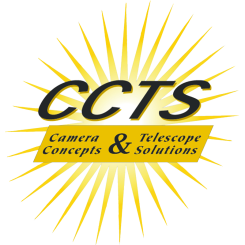Baader Planetarium Research Grade TZ-3 Telecentric System - TZ-3
| Article number: | TZ-3 |
| Availability: | More on the Way to us |
| Delivery time: | More on the Way to us |
- Research grade Telecentric device with an oversized pick up expanding lens set and 2" (50.8 mm) threads on each side. Includes a T2 adapter, and a 2" male/female inverter ring as standard equipment.
- H-alpha filter entry side has 46 mm clear aperture, sufficient for research grade SolarSpectrum H-alpha filters.
- Large 250 mm working distance for ideal focal length reduction with a telecompressor as well as for providing enough room for adapting a binoviewer.
- 3x focal length extension combined with aplanatic lens allows for a parallel f/30 beam to be achieved when used with ~f/10 optical systems free of field curvature.
- Calculated and produced primarily for 656.3 nm H-alpha, providing 99% Strehl (definition brightness).
- Diffraction limited design also works for CaK at 396 nm.
Working in conjunction with any SolarSpectrum H-alpha filter to supply sufficent backfocus, this 3x Telecentric Focal Extender also provides a parallel optical beam.
As both Telecentric optics and barlow lenses are used for focal length expansion, they are often confused for each other. Telecentric systems are designed to have the exit pupil positioned at apparent infinity, which indicates that the center ray from any point in the field appears to originate from infinity and is therefore perpendicular to the image plane and parallel to the optic axis. This means the off axis beam arrives at the image plane with an angular geometry that is the same as the axial rays. All field elements appear to be on axis across the image plane, and, unlike a barlow lens, edge field rays are not tipped bundles.
As all the primary rays across the image plane are perpendicular to it, the rays at the field edge will pass through an etalon right in front of the focal plane with geometry akin to the rays on axis. Therefore, in an f/30 telecentric optical setup, the etalon detects the very same geometry clear across the field, and the spectral bandpass wavelength does not shift across the entire field of view.
Starting from an ~f/15 (+2x Telecentric), ~f/10 (+3x Telecentric), or ~f/7.5(+4x Telcentric) aperture ratio, Baader TZ systems produce a parallel beam with an aperture ratio of ~f/30. In the case of highly divergent telescope focal lengths, the telescope's clear objective aperture should be reduced in diameter to the point that the final resulting f/ratio is nearly f/30 again.
When measured from their rear lens, the working distance of the TZ system to the camera sensor ranges from 200 mm for the TZ-2 to 230 mm for the TZ-4 to 250 mm for the TZ-3. This allows for enough space for the H-Alpha filter housing as well as the majority of accessories such as a Baader 2" mirror diagonal or any imaginable camera device. All TZ-coatings are matched to the different lens glass-substrates and optimized for maximum throughput at 656 nm.
- Focal Length Extension: 3x
- Usage: H-alpha observation with SolarSpectrum filters
- Inner Connection (Lens Side): T-2 (M42x0.75), 2" thread
- Outer Connection (Lens Side): 2" thread
- Outer Connection (Eyepiece/Camera Side): T-2 (M42x0.75), 2" thread
- Weight: 13 oz. (0.37 kg)




